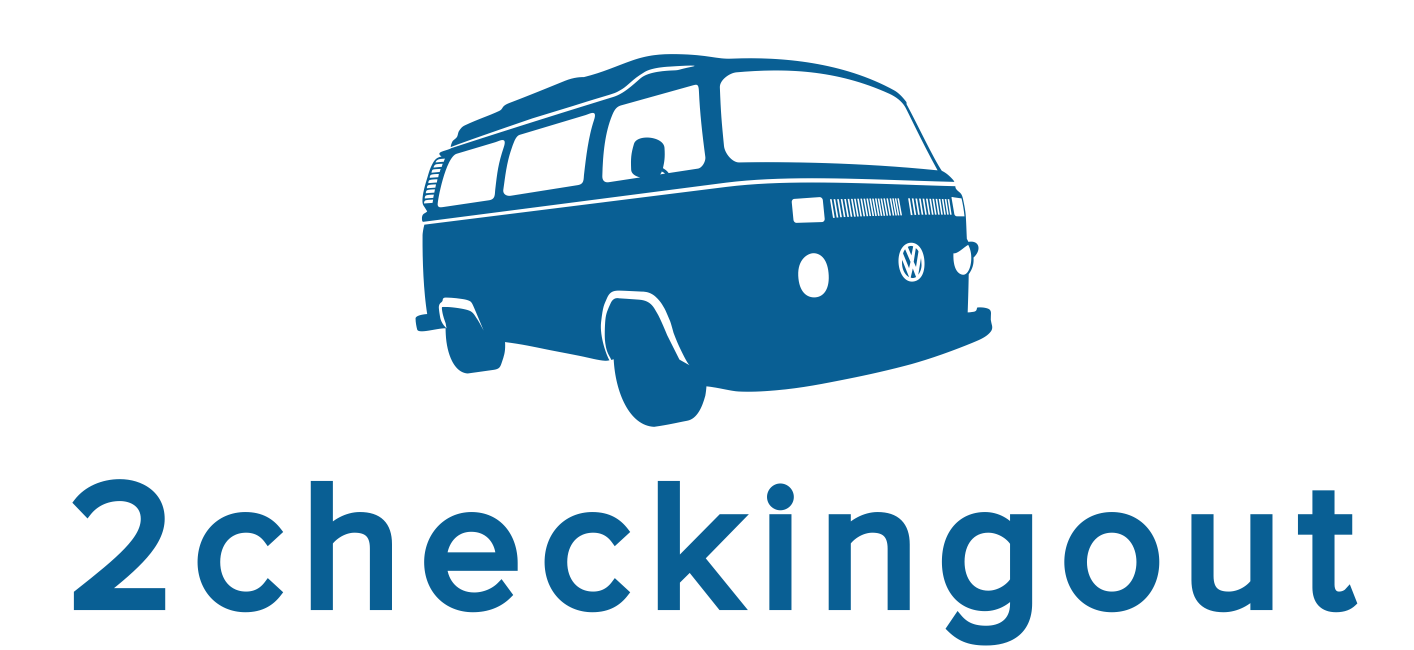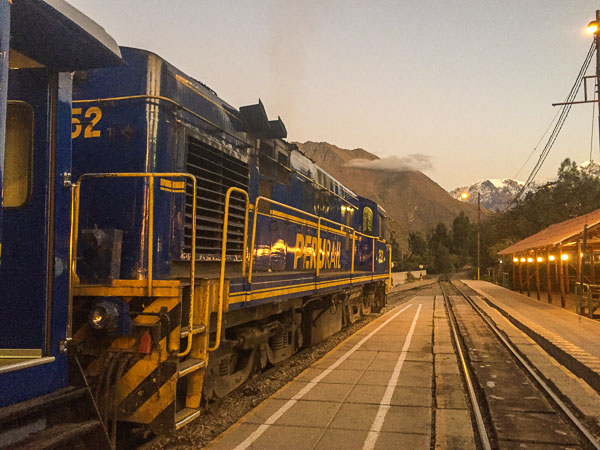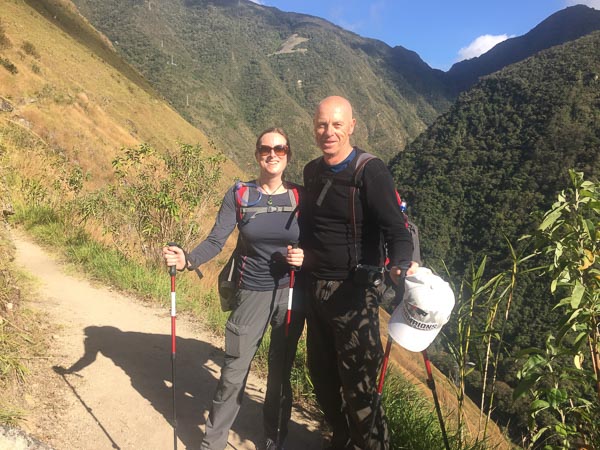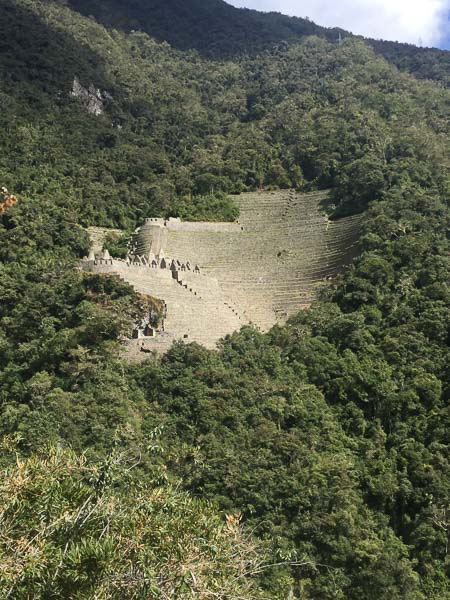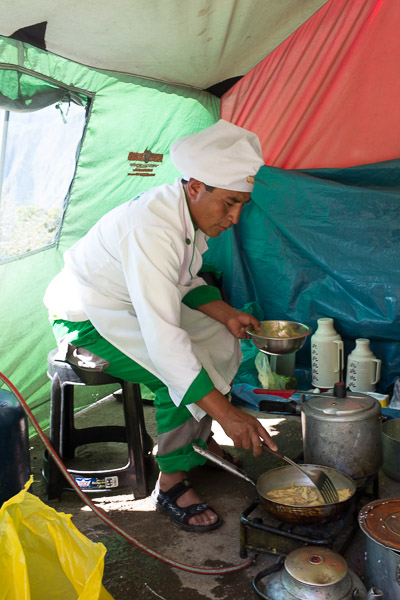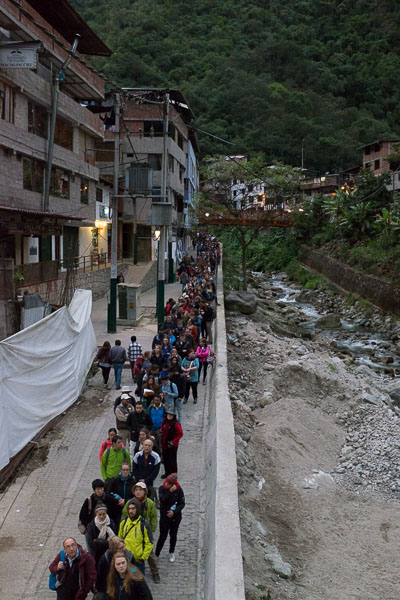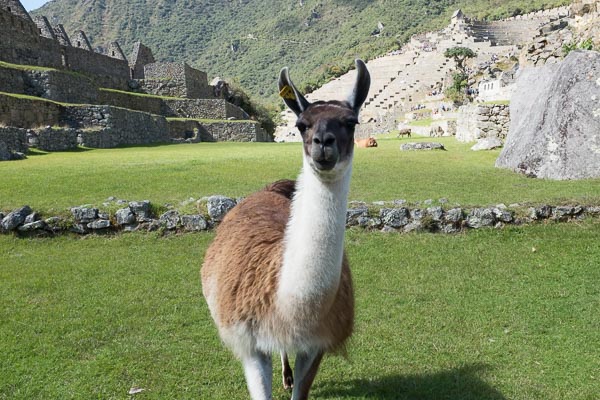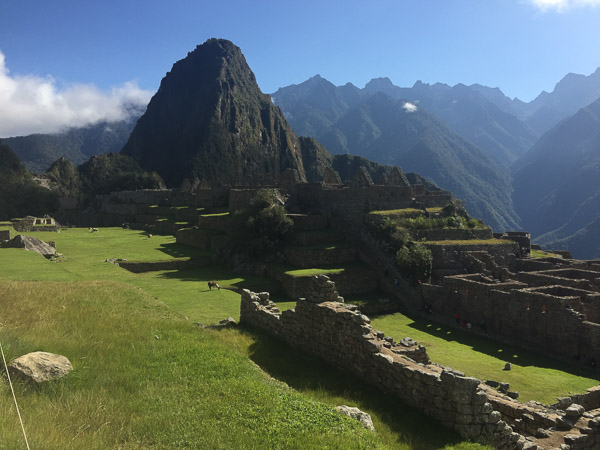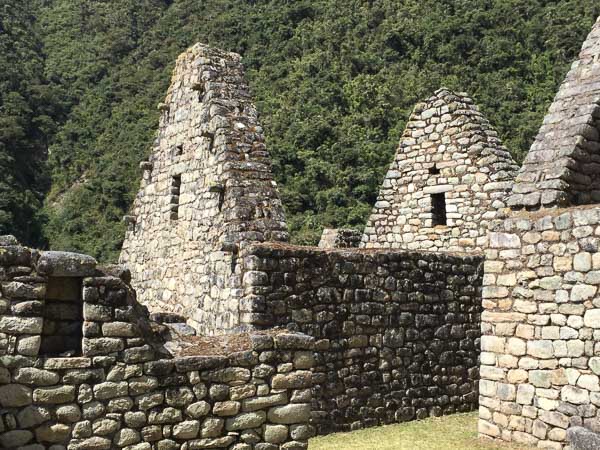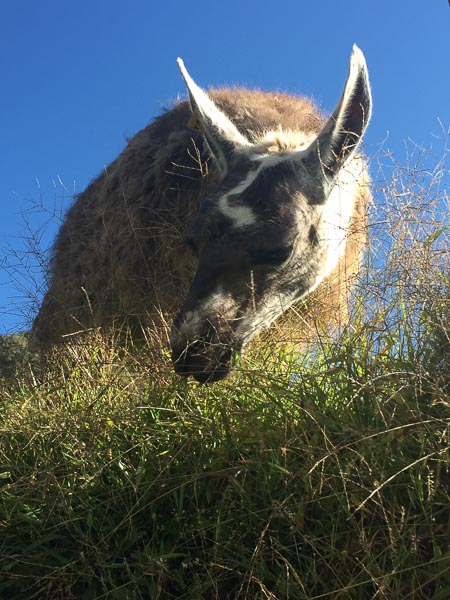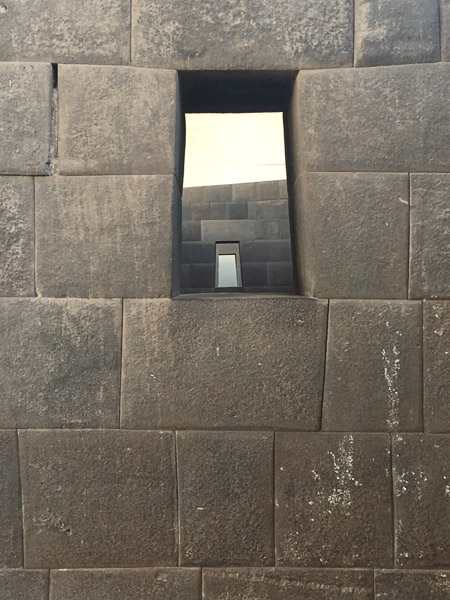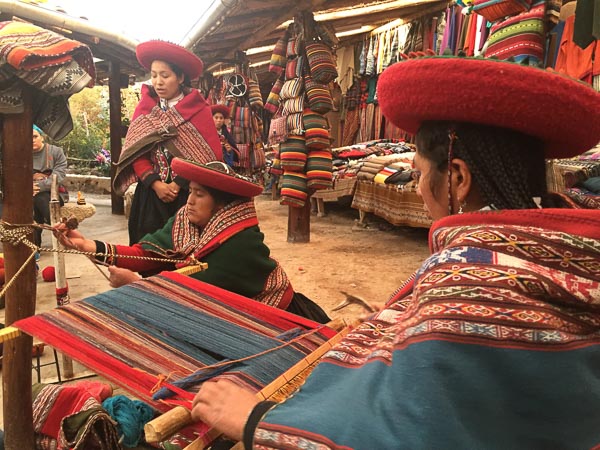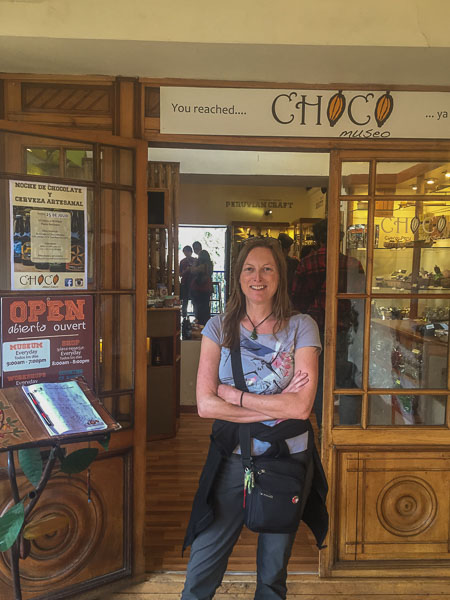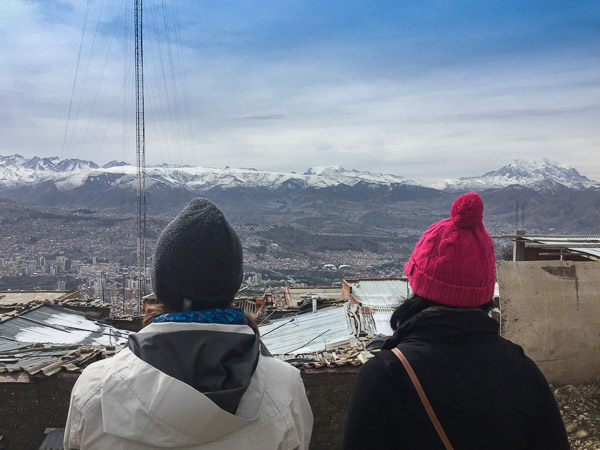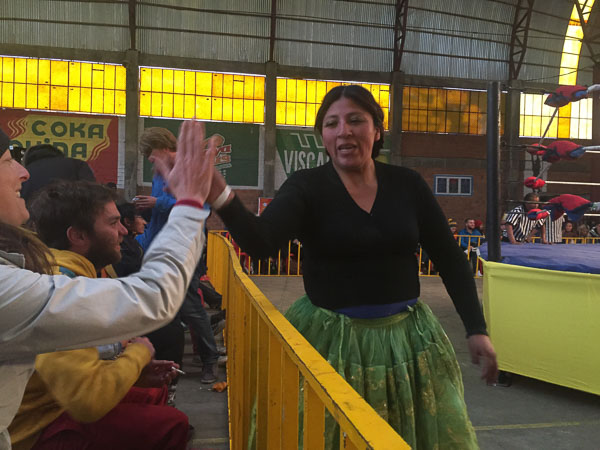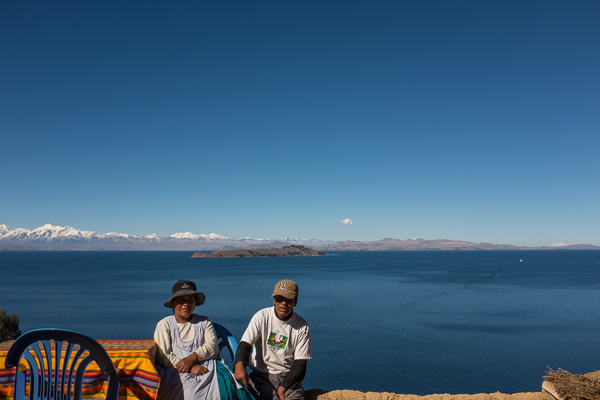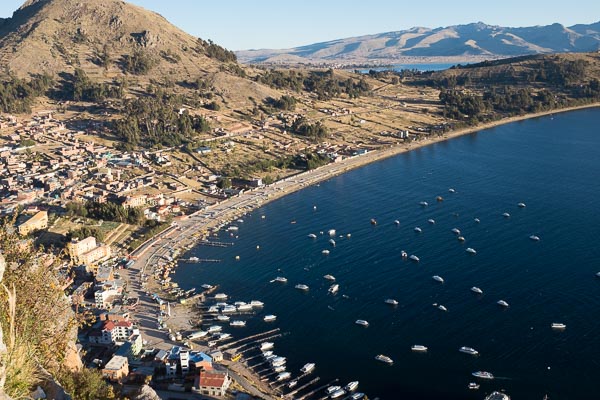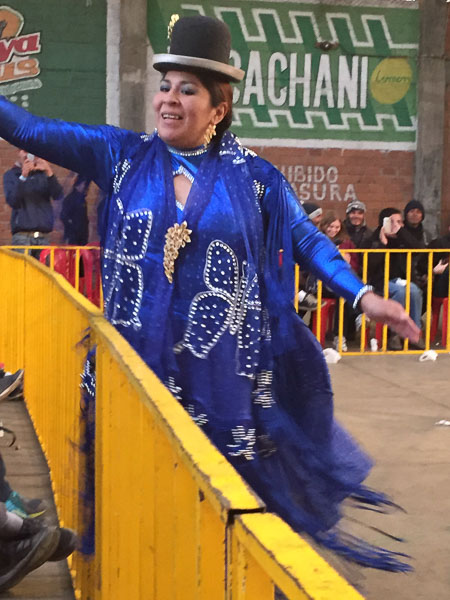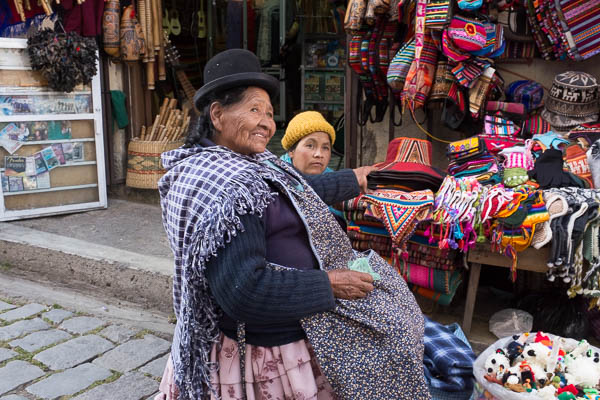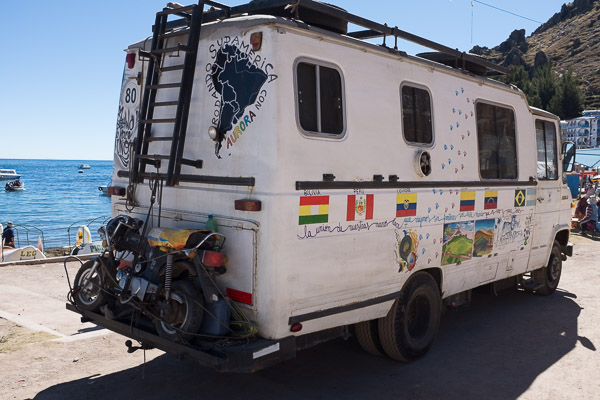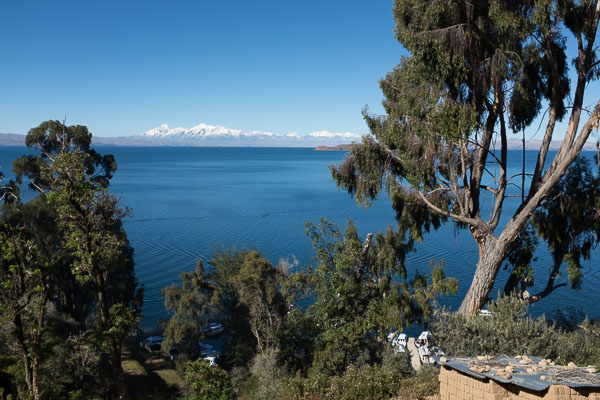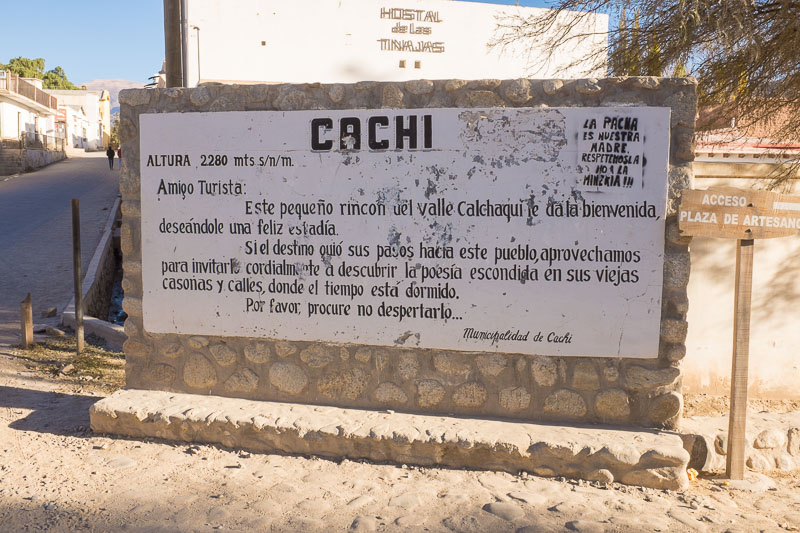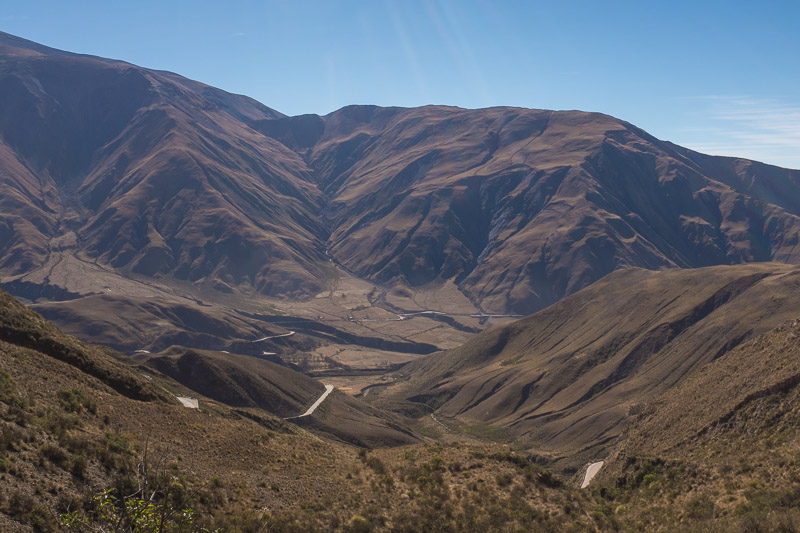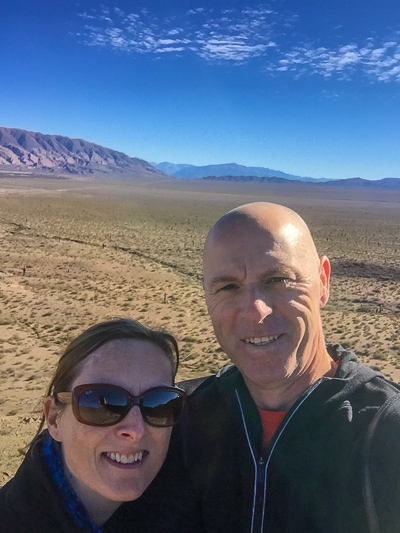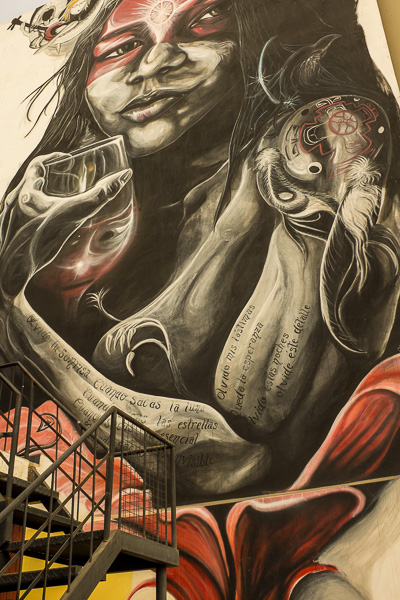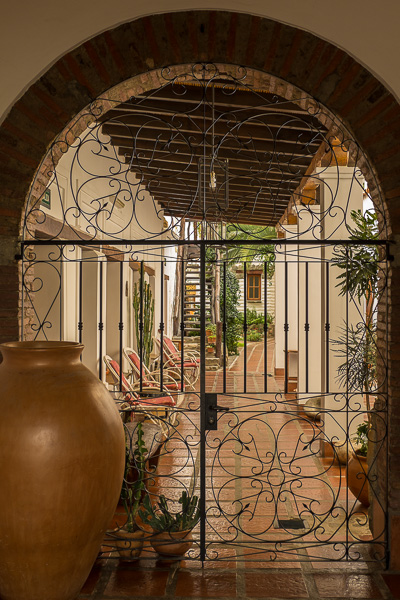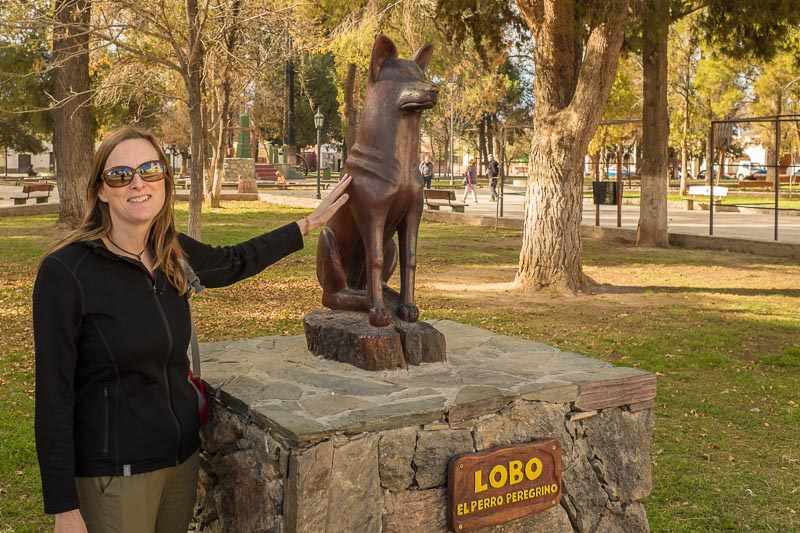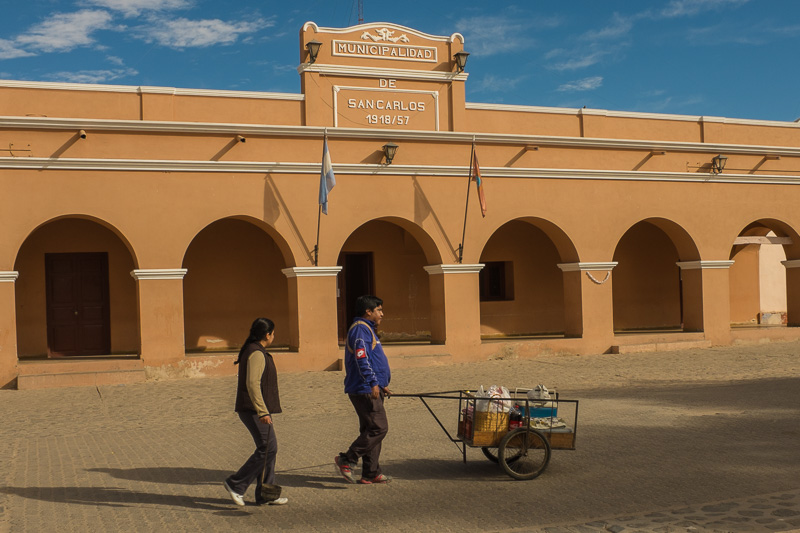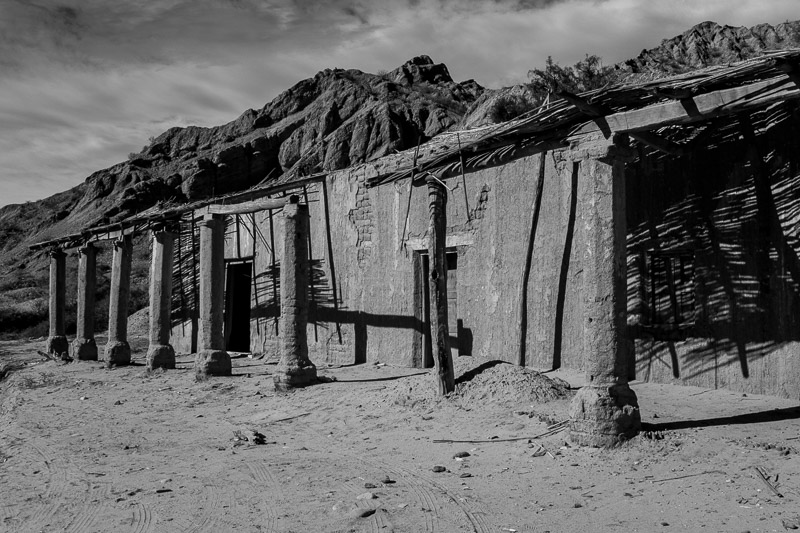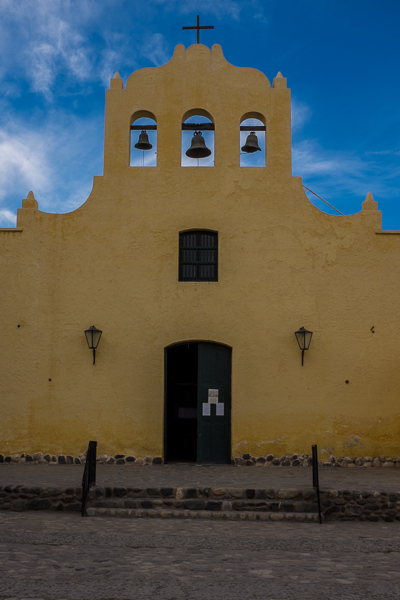Inca Life (Part 2): Machu Picchu from the 104 km Marker
We loved hiking Machu Picchu from the 104 km marker with a side hike up Wayna Picchu with Alpaca Expeditions. Perfect alternative to the popular 4 day Machu Picchu trek.
July 2015
Our journey to Machu Picchu started at 4.00 am as we were collected from the hostel and bundled into a minivan still half asleep. We stopped to pick up a few more people before heading out of town to Ollantaytambo for the 6.10 am train. We booked a two-day tour through Alpaca Expeditions who are highly rated on all the usual review sites. There are cheaper options, but these guys tend to get stellar reviews from everybody who has booked them. Muppet here really wanted to do the full 4-day hike but with a knee that has seen more operations than Elizabeth Taylor had marriages, common sense was beaten into me by Julie.
The train carriages are wonderful, very reminiscent of something you would expect to see on the Orient Express. Your seats are pre-booked along with your class of travel. Our carriage had huge ceiling windows that offered a spectacular view of the mountains as we chugged our way through the valley. There was even a hostess service offering free tea, coffee and snacks.
An hour and twenty minutes into the journey, the train came to a shuddering halt at the 104 km marker. Along with our guide, we jumped down the 1-metre drop to the side of the track. We were the only ones on a packed train to disembark here. Reminded me of the old Cary Grant suspense movie, To Catch a Thief. Some may think I'm showing my age; I like to think it's good taste.
Cary Grant on the left....
A short walk to a swing bridge, then a permit checkpoint including a stamp in our passport and we were on the Inca Trail. There are, in fact, many Inca trails; some well-used, others abandoned to nature. Shortly after the checkpoint, we came to our first Inca ruin, Chachabamba. A small site that was once a checkpoint and lookout for the Incas.
Chachabamba checkpoint
We started the trail at an altitude of 2,000 metres or 6,000 feet for the imperial readers. We then hiked for 3 hours along a path that wrapped around the mountain.
Our guide for the two-day trip was Eddy. A nice guy who was incredibly patient and coaxed us along when the going got tough. His constant reminders to drink water kept us hydrated on a warm day. A big bonus was that we were the only people on the tour, out of what could have been a group of twelve people.
Close to midday across the valley, we saw the Inca site, Winay Wayna, which means forever young. An hour later, we were climbing the steps between the terraces of this fantastic ruin. And we had the place to ourselves. Eddy took us to different points throughout the ruins explaining the history and importance of the various buildings.
I guess there are different versions of what the Incas stood for and how they treated the locals of the lands they conquered. The version we had from Eddy was that they allowed the locals to continue to worship the various gods that were important to them as long as the Inca Sun God came first.
They were very much into collaboration and hard work. The one Inca saying that stood out for us is ‘for you today, for me tomorrow’. Interestingly, the Incas did not use prisons; they just made the naughty people work twice as long. The belief is that working twice as long was better than sitting around on their backsides.
Thirty minutes after Winay Wayna we stopped for lunch at the four-day hike camp.
The porters who accompany the hikers had set up a tent/dining room complete with tables and chairs. Lunch was terrific given that we were miles away from anywhere. They even knew Julie was a vegetarian and provided several yummy options. Something the guys from Pantanal Discovery could learn from (still no promised refund!).
The camp was almost deserted, except for the porters and the three of us. Come evening, there would be over 500 hikers parked up on ledges and overhangs.
After lunch, we set out on the final two hours of walking before arriving at the Sun Gate. From the moment we jumped off the train, we couldn’t have seen more than half a dozen other people. So lucky to have this unique trail to ourselves.
A walk with a view
The arrival at Inti Punku (Sun Gate) just blew our minds. Looking down on Machu Picchu for the first time is a moment that will stay with us forever. But who were these people imposing on our moment? Transpires you can walk up from the main complex to the Sun Gate, doh.
During the summer and winter solstices, the sun rises and shines through the Sun Gate down onto specific Sun Temple windows. That would be a special moment to witness. It was amazing to think that the Inca King was carried twice per year to this site to see this marvel. It took the best part of an hour to walk down from the Sun Gate to the main complex. We passed lots of red-faced people walking in the opposite direction.
After having the trail to ourselves, it was quite a shock to be among the selfie stick waving hoards everywhere in the main complex. We had a quick gander at a couple of locations and decided to catch the bus down to Aguas Calientes before the queue got too long. The trip down is quite entertaining; 9 km and 13 hairpin bends with buses meeting at every corner. It was almost one of those close your eyes and hope for the best bus rides.
The town of Aguas Calientes is the gateway to Machu Picchu for everybody who has not hiked in. This small town is where the train terminates. In fact, the train line runs through the centre of town. You can be sat having a beer waving to everybody on the train heading out of town.
Our hotel room was the size of a shoebox but had three big pluses, a hot shower, shampoo and a hairdryer; well, at least one of us could use the hairdryer. We joined Eddy for dinner at an OK restaurant and retired early, pretty bushed.
A very happy bouncy Eddy met us the following morning at 5.45am. The queue for the bus to Machu Picchu already stretched halfway through town. We watched in awe as guys ran wheelbarrows full of cement uphill from the bottom of town to the main centre while we waited. All traffic except for emergency vehicles is banned from the top half of town. Goods and produce have to be wheelbarrowed in.
It took over 45 mins before we managed to set foot on a bus and then another 35 minutes to reach the entrance. We missed the sunrise but still managed to find a few quieter locations without too many people to get in the way of photos.
Eddy was again a mine of Inca history as we weaved through the cemetery, King’s residence, Sun Temple, Temple of the Condor, and various other key sites. The Spanish never found Machu Picchu, so it was left to Hiram Bingham and his team to uplift much of the treasures and whisk them back to Yale University and other private collections.
We said goodbye to Eddy at 9.30am, and by then, the armada of buses had deposited hordes of visitors. There is apparently a limit of 2,500 visitors on top of the hikers per day. It felt more like 25,000 as patience started to wear thin.
Overlooking Machu Picchu is the imposing mountain Huayna Picchu. You know what they say about mad dogs and Englishmen? Yep, we had booked to climb The Stairs of Death in the middle of the midday heat. A separate ticket is required for the climb, with a limit of 400 people per day split into two groups.
The climb is huge, with massive stone steps, narrow walkways, steel ropes to help with the steepest parts and finally, a small cave to crawl through.
Julie had a vision of me being stuck in the short tunnel blocking the way for everybody else. Luckily I have lost a few kilograms since starting our overseas adventure.
You could feel the invisible gloat of the folk on the way down, thanking the Sun God that they had chosen to climb earlier in the day and now had the sun on their backs. Occasionally somebody would say, ‘nearly there’ or ‘it’s just around the corner’ with that wry smile of somebody who had already conquered their own Everest.
At the top, you are rewarded with the most stunning view of Machu Picchu and the surrounding countryside. There is no health and safety at the top as visitors jostle each other for that perfect instagram moment on the edge of a sloped rock where one false move sees you take the express route back to Machu Picchu.
It’s unbelievable that without the aid of modern machinery, the Incas built a lookout complete with a temple and living quarters for those manning this guard post.
And the view is not bad either
The descent down was almost as arduous as the climb. And for us, there was nobody to tease with 'you're almost there'. The quads and glutes were screaming by now. We caught our breath at the bottom in a shady area and made friends with a couple of groovy llamas.
We trudged our way back to the entrance, where the wait for the buses was over 45 minutes. Again in Aquas Calientes, we grabbed a beer and pizza before catching the train back to Ollantaytambo. Despite the stunning scenery that runs alongside the track, there was lots of dozing people glad of the rest-bite after a hard day slogging round this fantastic world heritage site.
We spent our last night in Cusco at a Hostel Pisko & Soul, just opposite our previous home. This one not quite as friendly as El Grial, but hey, it was a bed for a night after a couple of long days.
Cusco is a beautiful city. History drips from every Inca stone and narrow street. The old town is just the right size to wander by foot. You don’t get the feeling that you are in a city of over 300,000. Yep, there is more than fair few tacky tourists shops, but you don’t feel overwhelmed. There is a brilliant indoor market that straddles the border between the new town and the old town.
The accommodation cost is probably the most expensive in South America, but you can find some great food at bargain prices. And of course, there is always happy hour, 2 for 1 pisco sours.
Visiting the Sacred Valley, then the Inca ruins behind the city and finally Machu Picchu was incredible. The fact that the Incas carved these massive stones, hauled them over mountain ranges and fitted them together like Lego without mortar is just mind-blowing. Photos do not do justice to the sheer scale of what those clever Incas achieved.
Next stop, hopping our way to Ecuador.
Inca Life (Part 1): Exploring Cusco and Surroundings
Wondering what to do in Cusco? Come with us as we discover Qorikancha, Saqsayhuaman, Sacred Valley, Ollantaytambo and Chinchero in part one of Inca Life.
We woke at 5.00am to find ourselves parked outside the old part of the Inca capital Cusco. The Bolivia Hop bus had miraculously turned into the Peru Hop bus at the border. Same company, same excellent service, just differently coloured buses. Large buses and lorries are banned from entering Cusco town. So the Peru Hop guys had arranged a fleet of taxis to ferry us to our hostel.
We stayed in an older part of the old town called San Blas. Narrow one-way streets with a neat square and imposing looking church. The taxi driver found the road OK but couldn't locate our hostel. Turned out the numbering system in the street was a little haywire. After an early morning grumbles with each other and feeding a payphone without hitting the jackpot, we eventually found our hostel. Hostel El Grial was at the opposite end of the street to where it should be. Who has 110, 114, 116 at one end of the street and 112 at the complete opposite? The modern street designers could take a lesson or two from the Incas.
San Blas Square
Much of the accommodation in Cusco is pricy. Even private rooms in some of the more basic hostels are NZ$50-$60 per night. The price you pay for stopping off in the busiest city in Peru. El Grial was a great little find. Run by some friendly hosts and came with the hottest, most powerful shower we had had in months.
We had a few days to explore the city and surrounding area before our two-day hike to Machu Picchu. We made the most of the fantastic hot weather by hanging out on balconies drinking beer, and watching the world go by. In the evenings, we would seek out bars around our hostel serving happy hour '2 for 1' pisco sours. Between we explored this beautiful city.
Just down the road from the hostel was a great food find, the Green Point Vegan Restaurant. A three-course lunch, with salad bar, and juice only NZ$6 each. The tasty menu changed daily, and we were frequent visitors. Opposite Green Point is the Yoga Room. Julie's first yoga class came with two canine participants. Her second class entirely in Spanish. All those lessons in Sucre did come in handy.
yoga buddies...
Next door to the hostel is La Boheme serving the most amazing crepes filled with salted caramel ice cream. Washed down with a NZ$3.50 glass of yummy red wine. Yep, you guessed it, we went back on several occasions.
To get the best value for money, we purchased a Cusco Tourist Ticket. This passport-style ticket covers entry to several museums and historical sites in and around Cusco.
The museums are a bit hit and miss. The Museo Historical Regional is a beautiful building with some cool exhibits. The Museo de Arte Contemporaneo is a dive. Best avoided; use the time to find a bar serving pisco sours. Even worse is Museo de Arte Popular. This one comes complete with rude staff and is the basement room of an office block.
The Museo de Historia Natural is not included with the Tourist Ticket but was only NZ$1.50 entrance fee. In the back of a splendid building on the main square, some ancient stuffed animals need good dust and some glass jar exhibits that look like leftovers from a tequila party. Great for the inner kid, but don't expect to take longer than 10 minutes.
Also not on the Tourist Ticket is Qorikancha. A stunning looking building, which once upon a time was the Inca sun temple, the most important temple in the Inca world. The temple floors and walls were originally covered in gold. You will never guess what happened to the gold. The Spanish built the Convento de Santo Domingo del Cusco on the foundations of Qorikancha. The blend of the two buildings is one of the highlights of Cusco.
Following our visit, we found the highly rated Sharman Restaurant. A raw vegan cafe with an incredibly rude waitress and disappointing food that is twice the price of Green Point. So much for the rave reviews!
Qorikancha gardens a great place to chill and relax in the middle of the city.
Taking a left turn out of our hostel and following the route uphill for 30 minutes, you come across Saqsayhuaman.
In 1536 this vast Inca fortress was the last foothold against the conquering Spanish. This site is the size of a dozen football pitches and has been very well preserved. The main zigzag wall stretches for over 400 metres.
The most enormous stones weighed over 300 tonnes and were dragged into place by thousands of workers. Designed in such a way that the flanks of an attacking force would constantly be exposed. Clever buggers, those Inca folk.
Further down the road is Q'engo. An Inca rock worship site. To round out our cultural afternoon, we stopped at Cristo Blanco, the statue of Christ overlooking Cusco. The Incas designed the city in the shape of a puma's head, and from here, you can almost make it out.
steep but rewarding walk up to Saqsayhuaman
We booked a one day tour through the nearby Sacred Valley with Orellano Tours. The day started in chaos as the bus was late, and when one did turn up, it was too small for the group. Then given the ban on large buses we stopped and changed again just outside the old town. These guys do this every day of the week, all year round, but still couldn't organise a pub crawl in a brewery.
It turned out to be an informative, enjoyable day when we did get underway, albeit a little long. Our guide Marco had a great (sarcastic) British sense of humour. After a pee break at a tacky tourist truck stop that came complete with petting llamas, we made our way to the Sacred Valley.
The first stop was the Pisac ruined citadel. Sitting at the entrance to the valley, this impressive Inca site looks down onto the town of Pisac. Carved into the cliff face are hundreds of holes, tombs for the Inca elite. Raided by those pesky Spanish for the gold and artefacts buried alongside the dead. The terraces carved into the mountainside offered rich fertile food growing areas. The equivalent of the British allotment, these terraces contain four layers of stone and soil, brought from multiple locations. Underneath an irrigation system that allows some of the terraces to be still used today. Very clever, those Inca fellows.
amazing farming terraces at Pisac
Down in the town of Pisac, we stopped off at a silversmith. We were shown an award-winning silver sculpture and given the opportunity to see silversmiths at work. There is also a market catering to most tourist needs. Julie bought a scarf, but when we tried to haggle, we were met with blank expressions. I guess the ticket price is the price.
traditional dress v travelling dress, Pisac market.
The next major stop was at Ollantaytambo. The kickoff point for the famous four-day Inca Trail and the central railway station for those less inclined to hike to Machu Picchu.
Ollantaytambo is a pretty little town with cobbled streets. We climbed the 400 odd steps with farming terraces on either side.
Food storage areas sat high on the opposite cliff face. Food was stored high for three main reasons. The temperature at this height was ideal for preserving food. It avoided the floods that swept the valley regularly. And finally, it provided excellent security. Did we say those Inca fellows were quite clever?
There is an unfinished temple at the top of the ruins (thanks again Spain!).
Some weighing as much as 90 tonnes, the temple stones were hauled 12 kilometres from the other side of a nearby mountain range. The modern-day villagers, all 1,540 of them, proved this could be done, twice in fact. It took two and half months working 4-6 hours per day using the same tools that the Incas had. I'm pretty sure the Incas would have worked longer than 6 hours a day and wouldn't have stopped for morning tea. Certainly, not slackers those Inca boys and girls.
On the route back to Cusco, we stopped at a more recent Inca discovery, Chinchero. The Inca’s believed that this town was the birthplace of rainbows. It's here that we visited a weaving centre. Family groups that are direct descendants of the Inca have co-oped together to maintain this wonderful tradition. They create some fabulous items that are available to purchase.
What was quite amusing was the little cage under the fire that contained several dozen nervous-looking guinea pigs. The answer is no; we didn't get to taste guinea pig. Although one town we drove through had ladies standing on the road waving large sticks with roasted guinea pig impaled on them.
Despite the dodgy start this was a great day trip through a valley rich in Inca history. A long day but well worth the money.
Sacred Valley
On our return to Cusco, we tried the Moreno Peruvian Cafe. It’s here that Julie tried Inca Kola, which can only be described as sickly thick cough syrup. The kind that Mum forced down your throat at the first sign of a cold. You know the one that had been in the cupboard for at least five years and the use by date had long gone under a sticky mess. We washed away this disgusting goo with wine and a dessert crepe at La Boheme.
Yes it tastes as bad as it looks.
A must-do when in Cusco is chocolate making at Choco Museo. An enjoyable morning that provided a great insight into the many uses of the cocoa bean and the local cocoa industry. Surprisingly singing and dancing from all the participants was a requirement. The instructor for the morning a fun-loving guy with a smile that stretched from ear to ear. In the end, we left with a bag full of chocolates that we had created ourselves.
After a great introduction to Cusco, we were excited for the main event. Next stop Machu Picchu.
Blame it on El Papa: Misadventures in La Paz
Things don't go according to plan in La Paz, Bolivia. But chilled out Copacabana on the edge of Lake Titicaca more than makes up for it.
The flight into La Paz on a cloudless day offers stunning views of the world's highest capital. Rugged mountains to either side of the plane with the city clinging at a seemly impossible angle.
The airport sits at an altitude of over 4,000 metres. The drive into the city drops nearly 700m down a long winding expressway. Along the route, when we arrived, were teams of busy bees. Some planting new flower beds, some trimming trees, some covering graffiti, and others fixing the holes in road. Somebody important is coming to town, and it's not us!
During the few days that we were in town, many thousands of dollars were being spent sprucing the place up. All this for a four-hour visit from the Pope. This papal tour to South America focused on the poorer countries.
The irony is that these countries spend millions of dollars to accommodate the visitor and become a whole lot poorer in the process. Then, of course, you could argue they became a whole lot richer spiritually.
For our stay in La Paz, we booked an AirBnB apartment. The apartment owner is one of the lucky few with a ticket to a special mass given by the Pope.
Our BFF travel mate Trish (T-Rex) also joined us for a few days. Well, eventually. Her flight was cancelled, and she had to take an overnight bus from Sucre. The poor wee thing arrived a very tired little bunny early in the morning.
Wandering the central downtown area, we found one little lane, Calle Tarija, with several good bars and cafes. One, The English Pub was packed to rafters for the final of the Copa America. We managed to bag a comfy sofa and, with beers in hand, cheered on Chile to victory. Gooooooooool! The lane is also home to a great little Mexican restaurant called La Cueva. So good we visited three nights running.
One of the must-do activities whilst in La Paz is 'The World's Most Dangerous Road'. We had booked in with Gravity Bolivia to bike the 63 kilometres known by locals as 'Camino de la Muerte' or Death Road to us. Before a new road was built, an estimated 200-300 people were killed each year, more than justifying the name. There are parts of the road with 1,000 metres (3,300 feet) of sheer drops on one side and mountain overhangs on the other. Since 1998, eighteen cyclists have died. And this is one of the top 'must do's' when travelling through Bolivia. Go figure.
Our first attempt was on Friday. We rocked up at the appointed time only to find that the group had left an hour earlier. The police had closed all the roads out of La Paz for a practice run of the Pope's arrival. A mix up with our Gravity booking meant nobody had bothered to inform us of the change.
Take two was on Monday. We again climbed out of bed at 5.00am and walked down to the meeting location. This time several people were waiting, phew. Just minutes before the departure time, a staff member informed us that there was an itsy bitsy issue. The local villagers were protesting over some taxes and had blockaded the road. There would be no ride today. We were told that these things tend to blow over in a few hours, and tomorrow should be good.
Take three; once again, the alarm woke us from a dream laden sleep. Gravity had been keeping us updated via email the day before, and nothing had come through this morning. A quick breakfast, and we dressed and ready for action. One last check of the email before leaving. DOH. There it was. The blockade was still on, and again there would be no ride today. Well, at least this time we didn't make the 20 minute walk into the centre. Back to bed.
After three attempts and running short on time, we decided to pull the plug. Clearly, somebody was trying to tell us that riding The World's Most Dangerous Road was not meant to be.
Around the corner from where the Pope would be holding mass is El Mercado de las Brujas's witches market. Holes in the walls acting as market stalls. Llama foetuses and dried newborns llamas the hot speciality. These are used for offerings to the goddess Pachamama and buried under Bolivian houses. Not sure how NZ biocontrol would feel if these were in our carry on luggage.
Down from the market are quite a few clothing stores. On the lookout for a warmer jacket, I ended up looking after a stall for 40 minutes whilst the owner went off to check the warehouse for my size. With my beginners, Spanish, I didn't manage to get anyone to buy, but I also didn't lose any stock. Unfortunately, the North Face factory that these jackets came from made only one size regardless of the label.
On Saturday, the weather turned chilly, and snow started to fall. Great time to crank up the heater and watch some crap TV. One of the benefits of an Air BnB apartment.
Our sightseeing tour of La Paz was courtesy of the cable car system (Teleferico) that crisscrosses the city. Opened in 2014 and with over 10 kilometres of cable, it's the most comprehensive system in the world. With T-Rex, we took the Teleferico up to El Alto, which offers spectacular views of the city. Then we crossed to the other side of town and mooched through a shopping centre. The cable car gives you a bird's eye view into the rich and poor areas of La Paz. The poor regions far outnumbering the more affluent ones.
One of Julie's highlights was the Cholita Wrestling. The three of us booked into what promised to be an evening of cultural entertainment. Yeah right.
Transported in the world's oldest bus to a seedy part of town. The venue turned out to be a partially covered high school basketball court. For the next two hours, we shivered our butts off as women in national dress wrestled each other. There was even one bout between two tag teams of men and women.
The VIP seats (white plastic chairs) around the ring reserved for the tourists. The rowdy locals crowded together on the concrete bleachers. Before each bout, the wrestlers would dance around the ring providing photo opportunities.
The evening brought memories of World of Sport on Saturday afternoons. Big Daddy, Giant Haystacks and Mick MacManus. Now, they were real wrestlers. Yeah right.
For our last night, we returned to the lane of cafes and chose a veggie place. Food ordered, we then asked for a beer. El Papa strikes again; all alcohol sales banned for the next 24 hours.
To transport us from Bolivia to Peru, we had chosen a company called Bolivia Hop. Set up by two Irish backpackers, this company provides an easy to use bus service for travellers. We booked to travel from La Paz through to Lima via Cusco. The service gives you the option of hopping on and off in certain towns and cities. Our first stop was Copacabana on Lake Titicaca. With El Papa arriving, our departure time was brought forward from 6.30am to 4.30am. WHAT? We had to be out of the city before they started closing off the roads for the day.
Each Bolivia Hop bus comes with a guide; this first one was far too energetic and lively for the ungodly hour. And the bus was blooming freezing, so much so that duvets were provided. With a beanie, gloves, three layers of clothing and a duvet, we were still chilled to the bone.
The highlight of the trip to Copacabana came when we had to get off the bus and jump on a small boat to cross part of Lake Titicaca. The bus travelled over on a separate barge.
Copacabana is a small lakeside town with a great laid back feel to it. We stayed at a beautiful guest house with a Mediterranean look to the rooms. The only trouble is that the nights were freezing. So much so that we had not one but four water bottles to warm up the bed.
The day we arrived was a public holiday due to ???? You guessed it, the arrival of El Papa in Bolivia. So the town was busy with families picnicking and enjoying the beach. We found a bar with a rooftop terrace serving two for one Mojitos and watched the world go by.
I booked a trip to Isla de Sol which, according to the Incas, is the birthplace of the sun. A couple of hours crossing Lake Titicaca, then a couple of hours walking across the island and then back again. It was an OK excursion for the price (US$10) with some stunning views but not much else to write home about.
Behind our guesthouse was a walk to the proverbial hill overlooking the town and the lake. The walk at altitude was slow going and reached a height of over 4,000 metres. This walk had the heart beating as wildly as Animal from The Muppets. The sunset, however, made the struggle worthwhile.
So our time in Bolivia came to an end. La Paz is an exciting city. Somebody once said it has the hustle and bustle of an Asian city but with an American city's convenience. Not sure about that, but it was undoubtedly the busiest city we had been in during our stay in South America.
Also, being in town whilst they proudly prepared for the Pope added a certain something. La Paz has a reputation for being a dangerous city. Sure, in some parts, it is not recommended to wander with a map in hand. But we found that with sensible precautions, it was an exciting place to explore.
Missing out on Death Road was a huge disappointment. Sometimes things are not meant to be.
On to Peru.
Next stop, Inca life and Inca Cola
A Pinch of Salt Part One: Road Tripping The Salta Region
We hit the road to explore Salta, Argentina. Taking in the breathtaking spaghetti-western style scenery and cute towns of Cachi & Cafayate. Until disaster struck!
After being wowed by Mother Nature in the Pantanal it was time to return to Argentina. We made our way to Salta in north west Argentina. Covering the 2,300 kilometres with a combination of overnight buses courtesy of Flecha Buses and a night's stay in Puerto Iguazu. Not quite the luxury of our first bus ride.
Salta has a population of over 600,000 and is the second largest city in the region. It's a pretty city with lots of colonial style buildings and a neo-classical style cathedral. There's a blooming big hill that offers a great vista of the city. It's a great jumping off point to explore the surrounding countryside. It was also our last stop before heading into Bolivia.
Like most South America cities, the main plaza is a hive of activity. We stayed at Hostal All Norte, a little off the beaten track but cheap. Turned out we were the only guests staying during our two night stop. A little odd and with no background noise or music it was quite spooky at times.
Salta's main plaza is home to one of the strangest museums we have visited, the Museum of High Mountain Archeology. A museum dedicated to the ancient ritual of sacrificing young children by burying them alive. Two of the three mummies found are on display, fascinating, but morbid.
We took an early evening stroll up San Bernardo Hill, a climb of 1,070 stone steps. There was the option of taking a cable car, but one of us was clearly in the mood for some exercise. I guess we do have to get our fitness levels up for Machu Picchu. The view from the top was spectacular as the sun set over the city.
After a couple of days wandering the streets of Salta we hired a car and headed out of town. The plan was to explore south of Salta for three days and then north of city for three days.
As we left the city we passed through litter strewn villages and towns where locals seemed to live a fairly poor existence. Then the countryside started to opened up into beautiful mountainous landscapes. The Quebrada de las Conchas was a ridged and imposing terracota range. We stopped at Garganta del Diablo (Devil's Throat) - a deep gully formed in the rock.
Our first port of call was Cafayate, a small town in the heart of the wine growing region. A gorgeous looking town with one of the nicest plazas we have come across. We found a place to stay right on the square. Here we got chatting to a French couple that had taken a year to drive down from Canada in their 1965 split screen kombi. What a journey, especially with two young children.
The surrounding countryside at times reminded us of the old spaghetti western movies. Barren, with deep valleys painted in a multitude of reds and browns. Lot's of little villages with cute churches and not much else. We wouldn't have been at all surprised to see Clint Eastwood ride by.
Our next stop was the sleepy town of Cachi. Again the landscape was stunning, often lunar in appearance. The Quebrada de la Flechas (ravine of arrows) was particularly striking. We won't mention the missed turning which meant a 20 kilometre drive into the middle of nowhere, down an ever narrowing dirt track.
From Cachi we drove the long straight road known as Recta de Tin Tin, climbing high. Piedra del Molino mirador was the highest point (3,548 metres above sea level). Stunning views in every direction. Then the winding decent, hairpin bends, sheer drops and views to die for.
That night we stayed at the party hostel Loki Salta, which is a good 20 minutes drive from the city centre. Upon arrival we were issued with wristbands so the staff could distinguish the two of us from the only other guest. Guess they might have been expecting a rush. You can tell the party hostels by the huge chalkboard dedicated to the drinking prowess of the guests by nationality. The normal running order is 1. Australia, 2. UK, 3. Kiwi's. Something to be proud of, go Australia.
We ventured out for dinner in Campo Quijano and after visiting the night market we found a cute little restaurant down a back street. The very friendly owner welcomed us with open arms. We were the only non locals and for a good part of the meal the only diners. With only a verbal menu, we ordered steak and trout, both were to die for. We had played guess the bill, which turned out to be double our highest guess. Our most expensive meal so far in South America! So much for trying to eat where the locals hang out.
Back at the hostel we were assured that we would find an ATM at our next port of call that was approximately 2.5 hours north. We arrived in the dust bowl that is San Antonio de los Cobres. Situated at 4,000 metres above sea level, this was the highest we had been so far and boy was it cold. The town was home to two non working ATM's, a hostel that didn't take credit cards and a garage that dispensed petrol by the litre bottle. Our cash had run so low that we had to share one meal between us. Then keep our fingers crossed that we had enough gas to get back to Salta.
Retracing our steps we headed back to the city to grab some cash, fill the tank and then head out again. But luck wasn't on our side. Just one kilometre from the end of the gravel road an old truck zoomed by flicking up a rock that smashed the back window on the driver's side. Scared us both half to death. We limped back to the car hire company, trying to avoid billows of dust entering the broken window. After a brief discussion, we paid for the window to be repaired and baled on our plans to venture further a field.
With our tiki tour plans in pieces we spent the next couple of days chilling at Hostal Salta Por Siempre. This hostel has a cute central courtyard, a great place for planning our next steps.
Salta is a splendid looking city, we can understand why some travellers choose to spend quite a bit of time here. We both loved the small town of Cafayate, and could have happily sat in the square with a glass or two of Malbec and watched the world go by.
The regions majestic landscapes the best we had seen on our travels so far. But it was time to move on.
Next Stop, Bolivia and a much larger pinch of salt.
